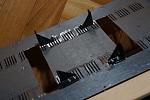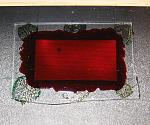TV developed from B&W viewed on small electrostatically deflected CRTs, like o'scope CRTs. Screen size wasn't over 7".
Next came electromagnetic deflection, and bigger screens. At first, small signal triodes like the 6SN7 were up to the task of driving vertical deflection coils. Bigger screens and wider deflection angles meant for more demanding vertical deflection duties. This led to a hardened 6SN7GTB with grid radiator wings, a higher plate dissipation rating, and the characteristic extended into V
gk > 0 territory.
Low-u power triodes eventually gave way to power pentodes for vertical deflection duty. Some of these types look like good audio finals. Unlike the HD types, these can use impedance match ratios more like audio finals, so stock OPTs can be used.
10JA5

This is a singleton power pentode with some excellent loadlines. It also doesn't have the top...




































